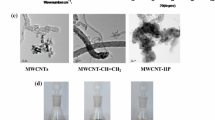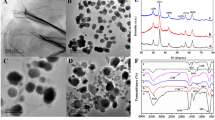Abstract
Considering the limitations associated with existing methods for the detection of trace amounts of trichlorfon, this paper proposes a novel molecularly imprinted electrochemiluminescence (ECL) sensor for the detection of trichlorfon by utilizing the double enhancement effect of trichlorfon and Ag nanoparticles supported by multi-walled carbon nanotubes (MWCNTs/Ag NPs) in a luminol–H2O2 ECL system. Here, trichlorfon was electropolymerized on the surface of the MWCNT/Ag NP–modified gold nanoelectrode with o-phenylenediamine to prepare the molecularly imprinted polymer-based sensor. After eluting the trichlorfon, imprinted holes for the identification of trichlorfon were retained on the sensor, which were used as signal switches to obtain different ECL intensities through the adsorption of different concentrations of trichlorfon. The ECL signal of the sensitized luminol–H2O2 was doubly enhanced by the MWCNTs/Ag and trichlorfon, improving the sensitivity of the sensor. The trichlorfon concentration was positively correlated with the enhanced ECL intensity of the sensor in the range 5.0 × 10−8–5.0 × 10−11 mol L−1, and the detection limit of trichlorfon was 3.9 × 10−12 mol L−1. Moreover, the proposed sensor was successfully applied to the detection of trichlorfon residues in real samples, and the recovery ranged between 91.8 and 109%.
Graphical abstract
A molecularly imprinted electrochemiluminescence sensor for trichlorfon detection by utilizing the double enhancement effect of trichlorfon and Ag nanoparticles supported by multi-walled carbon nanotubes in a luminol–H2O2 ECL system. The dual enhancement of the ECL signal improved the sensitivity of the sensor.






Similar content being viewed by others
References
Li Z, Wang Y, Ni Y, Kokot S (2014) Unmodified silver nanoparticles for rapid analysis of the organophosphorus pesticide, dipterex, often found in different waters. Sensor Actuat B-Chem 93:205–211
Povey A (2010) Gene-environmental interactions and organophosphate toxicity. Toxicol 278:294–304
Zha Y, Yang C, Lin L, Tao L, Cheng S (2011) Determination of trichlorphon residues in aquatic products using UPLC-MS/MS. Food Sci 32:278–280
He Y, Xu B, Li W, Yu H (2015) Silver nanoparticle-based chemiluminescent sensor array for pesticide discrimination. J Agr Food Chem 63:2930–2934
Sulaiman I, Chieng B, Osman M, Ong K, Rashid J, Yunus W, Noor S, Kasim N, Halim N, Mohamad A (2020) A review on colorimetric methods for determination of organophosphate pesticides using gold and silver nanoparticles. Microchim Acta 187:131
Alimohammadi Z, Pourmoslemi S (2021) Selective extraction of zolpidem from plasma using molecularly imprinted polymer followed by high performance liquid chromatography. Microchem J 162:105844
Li L, Zhou Z, Li X, Li D, Shen B (2021) An “off-on” electrochemiluminescence biosensor coupled with strand displacement-powered 3D micromolecule walking nanomachine for ultrasensitive detection of adenosine triphosphate. Microchim Acta 188:237
Kamyabi M, Alipour Z, Moharramnezhad M (2021) Amplified cathodic electrochemiluminescence of luminol based on zinc oxide nanoparticle modified Ni-foam electrode for ultrasensitive detection of amoxicillin. J Solid State Electr 25:445–456
Wang H (2021) Advances in electrochemiluminescence co-reaction accelerator and its analytical applications. Anal Bioanal Chem 413:4119–4135
Hu L, Lei M, Zhang J, Dong Y (2021) An “off-on-off” mode ECL sensor for drug detection based on the host-guest interaction of cucurbit[7]uril. Sensor Actuat B-Chem 344:130328
Liu P, Meng H, Han Q, Zhang G, Fu Y (2021) Determination of ascorbic acid using electrochemiluminescence sensor based on nitrogen and sulfur doping graphene quantum dots with luminol as internal standard. Microchim Acta 188:120
Liang Z, Zhang Q, Nie Y, Zhang X, Ma Q (2020) Polarized-electrochemiluminescence biosensor based on surface plasmon coupling strategy and fluorine-doped BN quantum dots. Anal Chem 92:9223–9229
Liu H, Yin H, Dong Y, Ding H, Chu X (2020) Electrochemiluminescence resonance energy transfer between luminol and black phosphorus nanosheets for the detection of trypsin via the “off-on-off” switch mode. Analyst 145:2204–2211
Xia M, Yang X, Jiao T, Oyama M, Chen Q, Chen X (2022) Self-enhanced electrochemiluminescence of luminol induced by palladium-graphene oxide for ultrasensitive detection of aflatoxin B1 in food samples. Food Chem 381:13227
Hinds B (2004) Aligned multiwalled carbon nanotube membranes. Science 303:62–65
Nirbhaya V, Chaudhary C, Chauhan D, Chandra R, Kumar S (2022) Multiwalled carbon nanotube nanofiller-polyindole polymer matrix-based efficient biosensor for the rapid detection of swine flu. New J Chem 46:6201–6211
Bozorgzadeh S, Haghighi B (2016) Enhanced electrochemiluminescence of ZnO nanoparticles decorated on multiwalled carbon nanotubes in the presence of peroxydisulfate. Microchim Acta 183:1487–1492
Wang R, Wu H, Chen R, Chi Y (2019) Strong electrochemiluminescence emission from oxidized multiwalled carbon nanotubes. Small 15:1901550
Tian L, Wu K, Hu Y, Wang Y, Lu J (2020) A molecularly imprinted electrochemiluminescence nanoprobe based on complexes consisting of CdTe and multiwall carbon nanotube for sensitive determination of clenbuterol. Microchim Acta 187:358
Tang Q, Shi X, Hou X, Jie Z, Xu Z (2014) Development of molecularly imprinted electrochemical sensors based on Fe3O4@MWNT-COOH/CS nanocomposite layers for detecting traces of acephate and trichlorfon. Analyst 139:6406–6413
Zhang G, Li M, Yu K, Chai H, Zhang X (2021) Two-dimensional metalloporphyrinic framework nanosheet-based dual-mechanism-driven ratiometric electrochemiluminescent biosensing of protein kinase activity. ACS Appl Bio Mater 4:1616–1623
Liu Z, Wang J, Lu Y, Cui C, Zheng L, Hu L (2021) Ultrasensitive prostate specific antigen monitoring based on electrochemiluminescent immune system with synergistic signal amplification effect of resonance energy transfer coupling with K2S2O8-H2O2 dual coreactants. J Electroanal Chem 899:115697
Cao J, Fu X, Zhao L, Ma S, Liu Y (2020) Highly efficient resonance energy transfer in g-C3N4-Ag nanostructure: proof-of-concept toward sensitive split-type electrochemiluminescence immunoassay. Sensor Actuat B-Chem 311:127926
Feng D, Wei F, Wu Y, Tan X, Han H (2021) A novel signal amplified electrochemiluminescence biosensor based on MIL-53(Al)@Cds QDs and SiO2@Au NPs for trichlorfon detection. Analyst 146:1295–1302
Pal A, Shah S, Devi S (2009) Microwave-assisted synthesis of silver nanoparticles using ethanol as a reducing agent. Mater Chem Phys 114:530–532
Liz-Marzán L, Lado-Tourino I (1996) Reduction and stabilization of silver nanoparticles in ethanol by nonionic surfactants. Langmuir 12:3585–3589
Kong L, Jiang X, Zeng Y, Zhou T, Shi G (2013) Molecularly imprinted sensor based on electropolmerized poly(o-phenylenediamine) membranes at reduced graphene oxide modified electrode for imidacloprid determination. Sensor Actuat B-Chem 185:424–431
Nagajyothi P, Reddy L, Devarayapalli K, Vattikuti S, Shim J (2020) Environmentally friendly synthesis: photocatalytic dye degradation and bacteria inactivation using Ag/f-MWCNTs composite. J Clust Sci 32:711–718
Kaur R, Rana S, Lalit K, Singh P, Kaur K (2020) Electrochemical detection of methyl parathion via a novel biosensor tailored on highly biocompatible electrochemically reduced graphene oxide-chitosan-haemoglobin coatings. Biosens Bioelectron 167:112486
Thota R, Ganesh V (2016) Selective and sensitive electrochemical detection of methyl parathion using chemically modified overhead projector sheets as flexible electrodes. Sensor Actuat B-Chem 227:169–177
Khan B, Farid A, Asi M, Shah H, Badshah A (2009) Determination of residues of trichlorfon and dimethoate on guava using HPLC. Food Chem 114:286–288
Acknowledgements
This project was supported by Key Laboratory of Tropical Fruits and Vegetables Quality and Safety for State Market Regulation (ZX-2022002), the Hainan Provincial Department of Science and Technology, China (ZDYF2020185), the Central Public-interest Scientific Institution Basal Research Fund (Nos. 1630082020001, 1630082022008), and China Agriculture Research System of MOF and MARA (CARS-31).
Author information
Authors and Affiliations
Corresponding authors
Ethics declarations
Competing interests
The authors declare no competing interests.
Additional information
Publisher's note
Springer Nature remains neutral with regard to jurisdictional claims in published maps and institutional affiliations.
Supplementary Information
Below is the link to the electronic supplementary material.
Rights and permissions
Springer Nature or its licensor holds exclusive rights to this article under a publishing agreement with the author(s) or other rightsholder(s); author self-archiving of the accepted manuscript version of this article is solely governed by the terms of such publishing agreement and applicable law.
About this article
Cite this article
Li, S., Luo, J., Wu, Y. et al. Determination of trichlorfon using a molecularly imprinted electrochemiluminescence sensor on multi-walled carbon nanotubes decorated with silver nanoparticles. Microchim Acta 189, 347 (2022). https://doi.org/10.1007/s00604-022-05452-w
Received:
Accepted:
Published:
DOI: https://doi.org/10.1007/s00604-022-05452-w




